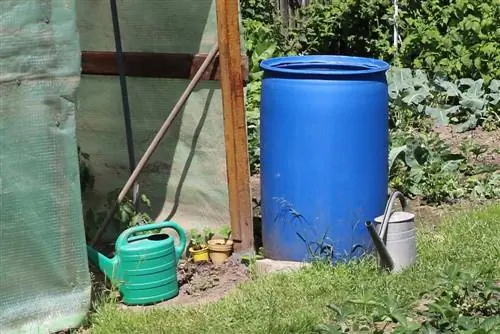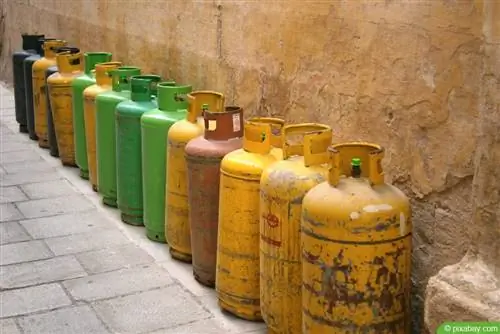- Author admin [email protected].
- Public 2023-12-17 03:39.
- Last modified 2025-01-24 12:45.
Whether and how you need to prepare your rain barrel for the winter depends primarily on the material it is made of. The material and workmanship quality and the location also play a major role. To ensure that your rain barrel gets through the winter safely and undamaged, you should take the right measures in good time.
Danger of frost for rain barrels
The combination of water and UV sunlight evenly removes the plasticizers from plastic rain barrels. The material becomes brittle. If water remains in the rain barrel in winter, it will increase in volume when frozen. That means it spreads out and pushes against the walls. The more brittle the walls are or the lower quality the material is, the more likely cracks are to form on the barrel walls. The rain barrel will leak and, in the worst case, can even burst over a large area.
Plastic bins
Not all plastic rain barrels are robust in frost. As a rule, frost-proof rain barrels are made of flexible polyethylene. This is not only environmentally friendly, but usually also weatherproof and frost-proof. But be careful, because in many cases the frost resistance is limited to certain sub-zero temperatures. In some cases, resistance to frost down to minus ten degrees Celsius is stated. But in many cases, frost resistance requires the water level to be drained or at least lowered. If the temperatures drop significantly below that, only very few plastic rain barrels can keep out the cold.
Rain barrels that have welded seams are particularly susceptible to cracks and bursting. In combination with inferior quality, they usually do not survive the first days of winter. You can find out from the manufacturer whether your plastic rain barrel is cold-resistant.
Winter Location
If you have a frost-proof rain barrel, it can usually remain in its usual place during the cold season as long as the temperatures do not fall below the temperature specifications set by the manufacturer. In principle, it is advisable to provide every plastic rain barrel with a place protected from the wind in winter. Icy winds can put additional strain on the material and even cause damage to frost-proof rain barrels.
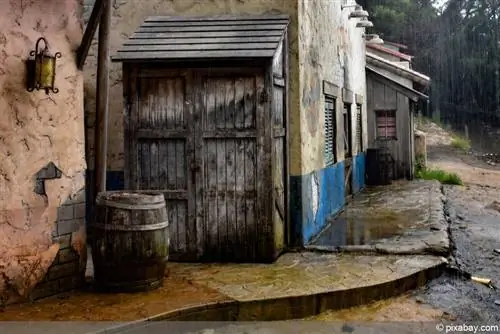
If an extremely cold winter is expected, you should play it safe and move your rain barrel to a warmer location, as well as non-frost-resistant specimens.
If your plastic rain barrel is embedded in the ground, you don't have to worry about frost-resistant models. Ground frost usually only affects the first few centimeters of the earth's surface. It will not cause any problems to the buried rainwater storage tank. In addition, the earth around the barrel keeps the walls stable and an expansion of the water content due to freezing is not to be expected if the tank is completely embedded in the earth.
Emptying/water level
For frost-proof plastic rain barrels that overwinter outdoors, the water level should not be higher than 75 percent. An even lower water level is optimal. In this way, the freezing water can expand upwards. This relieves the load on the barrel walls and significantly reduces the risk of damage.
However, the residual water usually creates an additional layer of ice. If this blocks the upward expansion, this has the same effect as if the barrel were completely filled with water. For this reason, it is essential that you regularly check your bin for layers of ice in winter and remove them.
Frost sensitive models
If your rainwater tank is not a frost-proof model, it must be completely emptied. While flexible polyethylene can withstand small expansions, in rigid materials just a few millimeters of expansion pressure can lead to cracks.
Wooden barrel
Wooden barrels are very popular as rain barrels, but require special care, especially for the wet winter season. This should be applied to the outside walls in the summer in the form of an impregnation layer. A combination of moisturizing and weather-protecting properties is recommended. If metal or cast rings surround the wooden barrel, care must be taken to provide sufficient rust protection to ensure stability is maintained and longevity is supported.
Winter Location
The wooden barrel can be left to overwinter outside or in a frost-free place. Of course, outdoors it is exposed to the cold weather. Since wood is robust and, in principle, extremely winter-proof, it is not necessary to move it to a warmer place.
Emptying/water level
As a rule, three quarters of the barrel can remain filled with water in winter. This is also recommended because the water pressure keeps the wood “in shape”. If you empty the wooden bin completely, the wood will contract. This means that the bin will probably leak in some places the next time it is filled the following year. But this is automatically corrected after a few days, because the moisture in the water then causes the wood to expand again and thus ensures the desired tightness.
Metal rain barrels
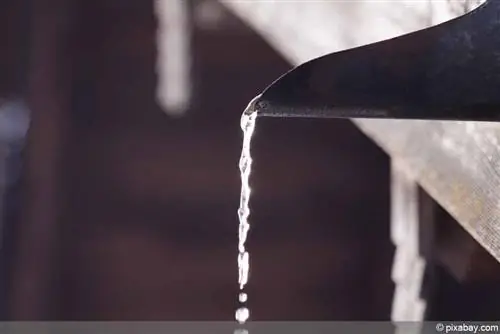
A metal rain barrel does not offer any flexibility in the walls. If frozen water expands, there is a high risk of leaky weld seams and solder joints or even the material tearing completely. Some people leave a little water in the barrel over the winter to create a heaviness and prevent the rain barrel from blowing away in the wind. However, here too, the remaining water can create additional ice surfaces that prevent upward expansion. With metal rain barrels, this can quickly lead to damage, especially at the junction between the wall and floor, if you do not break up the ice layer immediately. Since you probably don't want to check every day, it is advisable to always leave out the water from the metal rain barrel.
Rain barrels with foil
Rain collection containers that are lined with foil on the inside are a special feature. These are usually rain barrels whose outer walls only serve to guide/hold the film. Most of these are bottomless. This is represented by the slide. As a rule, the films are frost-proof and can be left outdoors for the winter. The border is predominantly made of wood or flexible winter-proof polyethylene. However, in winter there is a risk of the film being damaged by stones or similar sharp edges. If frost freezes the water and subsequently deprives the film of freedom of movement and stones are not pressed into the frozen ground by the weight of the water, they can cause small holes in the ground.
Empty correctly
With drain opening
As a rule, every type of commercial rain barrel is equipped with a drain opening or screw connection that is used for emptying. This is usually located on the barrel wall just above the base plate. Depending on the type of closure, it can be easily opened by hand or must be unscrewed with a screwdriver, for example.
Depending on how far you want to empty your rain barrel, let a corresponding amount of water flow out of the drain opening. The water level can only be lowered to the height of the drain opening without you doing anything. By tilting the rain barrel in the opening direction, additional water flows out. You can only get the remaining water out of the rain barrel by tipping it over. In many cases this requires opening a lid or another inlet/drain opening in the lid.
Without drain opening
Mostly wooden barrels or misused barrels that are used as rain barrels when there is no drain opening. But there are also rain tanks that only have a lid opening and no drain pipe at the bottom.
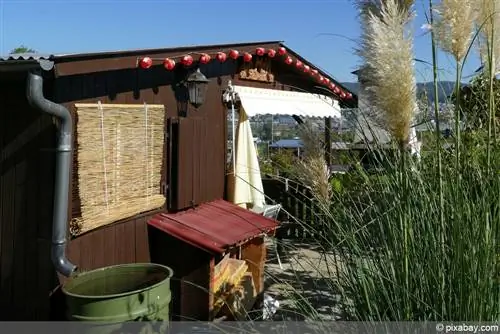
In this case, emptying can only be done by tipping the bin over. Especially when a rainy autumn causes high water levels, emptying can become a difficult task that not everyone is up to. Here it is advisable to prevent the inflow of water at an early stage so that the weight of the rain barrel is reduced if it tips over.
Closed column or underground tank
Emptying is different for versions that have neither a drain nor an inlet opening or underground tanks that are completely or partially embedded in the ground. For underground tanks, a water pump with a hose is required with which the water can be pulled out of the tanks. Hose sets are available for closed column tanks, which subsequently create a drainage option.
Tip:
When rain barrels are completely emptied, this is the perfect moment to carry out a thorough cleaning. In this way, you can use a high-pressure cleaner or water hose and brush to remove algae and dirt from the interior, for example.
Antifreeze preparations
Do not overwinter rain barrels in a frost-free place; regardless of the material, frost resistance and emptying/filling, further preparations should be made for the winter. These include:
- Prevent further water from flowing in after emptying
- Close with a lid or cover the upper area with something similar
- Wrap the rain barrel all around with foil (extends the lifespan of the material)
- Tip over completely empty rain barrels and weigh them down to prevent them from flying away
- Place frost-sensitive, emptied rain barrels on Styrofoam, cardboard or wood (acts as insulation against ground frost)
- In partially empty barrels, straw or reeds in the water prevent complete freezing

